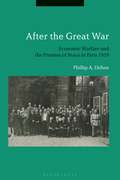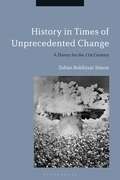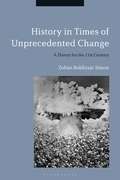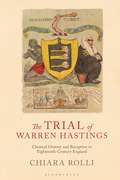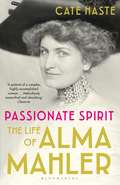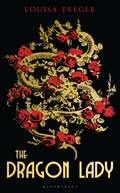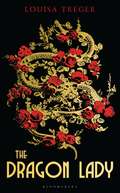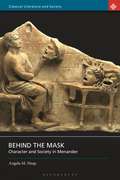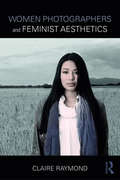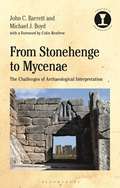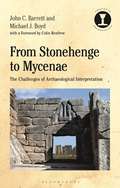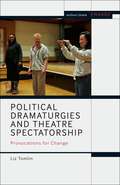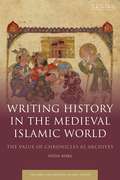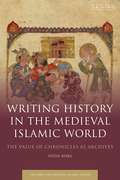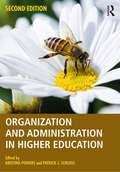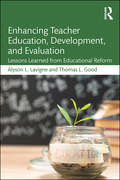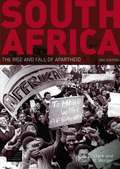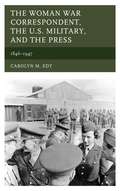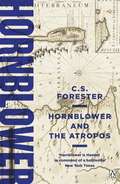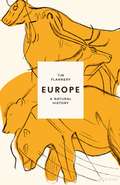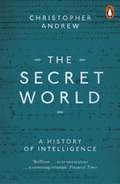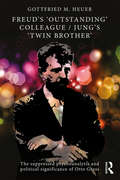- Table View
- List View
After the Great War: Economic Warfare and the Promise of Peace in Paris 1919
by Phillip DehneAt the Paris Peace Conference of 1919, the international community came together to find a way forward in the aftermath of the First World War. The conference is often judged a failure, as the resulting Treaty of Versailles did not bring long-term peace with Germany. By following the activities of British delegate and wartime Minister of Blockade Lord Robert Cecil, this book examines the struggles and successes of the conference, as delegates from around the world grappled with the economic, political and humanitarian catastrophes overwhelming Europe in 1919. After the Great War describes, for the first time, the significant role of economic warfare at the Peace Conference and in the post-war settlement. Lord Cecil's sometimes difficult partnership with US President Woodrow Wilson forged a new, permanent, international diplomatic organization – the League of Nations – and supplied it with the power to create collective blockades against aggressive states. Leaders of the Allied economic war before the Armistice became, in Paris, leaders of humanitarian-minded international outreach to their former enemies in Germany and Austria. After the Great War promotes a new understanding of these underappreciated internationalists in Paris, many of whom transitioned into leading the League of Nations even before the Peace Conference ended. Often derided as an idealistic fantasy, international peace enforced by economic sanctions appeared a realistic possibility when the Treaty was signed at the end of June 1919.
History in Times of Unprecedented Change: A Theory for the 21st Century
by Zoltán Boldizsár SimonOur understanding of ourselves and the world as historical has drastically changed since the postwar period, yet this emerging historical sensibility has not been appropriately explained in a coherent theory of history. In this book, Zoltán Simon argues that instead of seeing the past, the present and the future together on a temporal continuum as history, we now expect unprecedented change to happen in the future (in visions of the future of technology, ecology and nuclear warfare) and we look at the past by assuming that such changes have already happened. This radical theory of history challenges narrative conceptualizations of history which assume a past potential of humanity unfolding over time to reach future fulfillment and seeks new ways of conceptualizing the altered socio-cultural concerns Western societies are currently facing. By creating a novel set of concepts to make sense of our altered historical condition regarding both history understood as the course of human affairs and historical writing, History in Times of Unprecedented Change offers a highly original and engaging take on the state of history and historical theory in the present and beyond.
History in Times of Unprecedented Change: A Theory for the 21st Century
by Zoltán Boldizsár SimonOur understanding of ourselves and the world as historical has drastically changed since the postwar period, yet this emerging historical sensibility has not been appropriately explained in a coherent theory of history. In this book, Zoltán Simon argues that instead of seeing the past, the present and the future together on a temporal continuum as history, we now expect unprecedented change to happen in the future (in visions of the future of technology, ecology and nuclear warfare) and we look at the past by assuming that such changes have already happened. This radical theory of history challenges narrative conceptualizations of history which assume a past potential of humanity unfolding over time to reach future fulfillment and seeks new ways of conceptualizing the altered socio-cultural concerns Western societies are currently facing. By creating a novel set of concepts to make sense of our altered historical condition regarding both history understood as the course of human affairs and historical writing, History in Times of Unprecedented Change offers a highly original and engaging take on the state of history and historical theory in the present and beyond.
The Trial of Warren Hastings: Classical Oratory and Reception in Eighteenth-Century England
by Chiara RolliThe impeachment trial of Warren Hastings lasted from 1788 until 1795. Hastings was the first Governor-General of Bengal and his trial had a formative impact on the British Empire. Chiara Rolli shows that in an age when British education consisted mainly of classical studies, it was antique views of rhetoric and imperial governance that permeated the trial. Prosecutor Edmund Burke was figured as a modern-day Cicero fighting corruption in the colonies, while Hastings was Verres, the corrupt propraetor of Sicily in the first century BC. In their prosecution, both Burke and Richard Brinsley Sheridan employed certain coups de théâtre – such as fainting for emphasis – advised by Cicero and the later Roman rhetorician Quintilian, whose style of spectacular justice played particularly well amid the eighteenth-century vogue for sentimental drama. Burke's defence of natural rights and passion for extirpating vice in the colonies similarly reflected an admiration for Cicero, just as Hastings' preference to rule the conquered by means of their own traditions recalled models of Roman provincial administration. Using contemporary journalism, satire and other ephemera, the book reconstructs the public's equally profound grasp of these parallels. It illuminates new aspects of early British discourse around the Empire, and shows how deeply classical precedents influenced the cultural and political imaginations of eighteenth-century Britain.
The Trial of Warren Hastings: Classical Oratory and Reception in Eighteenth-Century England
by Chiara RolliThe impeachment trial of Warren Hastings lasted from 1788 until 1795. Hastings was the first Governor-General of Bengal and his trial had a formative impact on the British Empire. Chiara Rolli shows that in an age when British education consisted mainly of classical studies, it was antique views of rhetoric and imperial governance that permeated the trial. Prosecutor Edmund Burke was figured as a modern-day Cicero fighting corruption in the colonies, while Hastings was Verres, the corrupt propraetor of Sicily in the first century BC. In their prosecution, both Burke and Richard Brinsley Sheridan employed certain coups de théâtre – such as fainting for emphasis – advised by Cicero and the later Roman rhetorician Quintilian, whose style of spectacular justice played particularly well amid the eighteenth-century vogue for sentimental drama. Burke's defence of natural rights and passion for extirpating vice in the colonies similarly reflected an admiration for Cicero, just as Hastings' preference to rule the conquered by means of their own traditions recalled models of Roman provincial administration. Using contemporary journalism, satire and other ephemera, the book reconstructs the public's equally profound grasp of these parallels. It illuminates new aspects of early British discourse around the Empire, and shows how deeply classical precedents influenced the cultural and political imaginations of eighteenth-century Britain.
Passionate Spirit: The Life of Alma Mahler
by Cate HasteThe life of an extraordinary artist and intellect: the composer, author and socialite Alma Mahler, whose life spanned one of the most captivating and dramatic periods in historyBorn into the dying days of the Habsburg Empire, Alma Mahler was at the epicentre of fin de siècle Vienna's artistic and intellectual life. A talented composer in her own right, she was open, generous, remarkably creative, curious, challenging and zealous in her pursuit of love. Artists, architects, musicians and writers jostled to join her coterie. Gustav Mahler was her first husband; Gustav Klimt her first kiss.The great men who were drawn into Alma's wake would be indelibly touched by her power and brilliance: from her second husband Walter Gropius, founder of the Bauhaus and modernist architecture, to the Expressionist painter Oskar Kokoschka and her last husband, writer Franz Werfel. But her life was inflected by tragedy, and the love, support and inspiration that Alma gave to the men she loved came at the heavy price of her own artistic fulfilment. As the turmoil of her century uprooted her from her homeland and she fled Austria first for occupied France and then America, it would be her love of music alone that sustained her through a series of great losses. Drawing extensively on hitherto unpublished diaries and letters, Cate Haste illuminates the passionate spirit of one of history's most complex and charismatic muses, a modern woman with an elemental vitality that could scarcely be contained by her century – who will live forever in the art she created and inspired.
The Dragon Lady
by Louisa Treger'A daring blend of romance, crime and history, and an intelligent exposé of the inherent injustice and consequences of all forms of oppression' Tsitsi Dangarembga, Nervous ConditionsOpening with the shooting of Lady Virginia 'Ginie' Courtauld in her tranquil garden in 1950s Rhodesia, The Dragon Lady tells Ginie's extraordinary story, so called for the exotic tattoo snaking up her leg. From the glamorous Italian Riviera before the Great War to the Art Deco glory of Eltham Palace in the thirties, and from the secluded Scottish Highlands to segregated Rhodesia in the fifties, the narrative spans enormous cultural and social change. Lady Virginia Courtauld was a boundary-breaking, colourful and unconventional person who rejected the submissive role women were expected to play. Ostracised by society for being a foreign divorcée at the time of Edward VIII and Mrs Simpson, Ginie and her second husband ,Stephen Courtauld, leave the confines of post-war Britain to forge a new life in Rhodesia, only to find that being progressive liberals during segregation proves mortally dangerous. Many people had reason to dislike Ginie, but who had reason enough to pull the trigger? Deeply evocative of time and place, The Dragon Lady subtly blends fact and fiction to paint the portrait of an extraordinary woman in an era of great social and cultural change.
The Dragon Lady
by Louisa Treger'A daring blend of romance, crime and history, and an intelligent exposé of the inherent injustice and consequences of all forms of oppression' Tsitsi Dangarembga, Nervous ConditionsOpening with the shooting of Lady Virginia 'Ginie' Courtauld in her tranquil garden in 1950s Rhodesia, The Dragon Lady tells Ginie's extraordinary story, so called for the exotic tattoo snaking up her leg. From the glamorous Italian Riviera before the Great War to the Art Deco glory of Eltham Palace in the thirties, and from the secluded Scottish Highlands to segregated Rhodesia in the fifties, the narrative spans enormous cultural and social change. Lady Virginia Courtauld was a boundary-breaking, colourful and unconventional person who rejected the submissive role women were expected to play. Ostracised by society for being a foreign divorcée at the time of Edward VIII and Mrs Simpson, Ginie and her second husband ,Stephen Courtauld, leave the confines of post-war Britain to forge a new life in Rhodesia, only to find that being progressive liberals during segregation proves mortally dangerous. Many people had reason to dislike Ginie, but who had reason enough to pull the trigger? Deeply evocative of time and place, The Dragon Lady subtly blends fact and fiction to paint the portrait of an extraordinary woman in an era of great social and cultural change.
Behind the Mask: Character and Society in Menander (Classical Literature and Society)
by Angela M. HeapThis new study of Menander casts fresh light not only on the techniques of the playwright but also on the literary and historical contexts of the plays. Menander (342/1-292/1 BCE) wrote over a hundred popular comedies, several of which were adapted by Plautus and Terence. Through them, he was a major influence on Shakespeare and Molière. However, his work survived only in excerpts and quotation until some significant texts reappeared in the nineteenth and twentieth centuries on papyrus. The mystery of their loss and rediscovery has raised key questions surrounding the transmission of these and other Greek texts. Theatrical masks from the fourth century BCE discovered on the island of Lipari now also provide important material with which this book examines how the plays were originally performed. A detailed investigation of their historical setting is offered which engages with recent debates on the importance of social status and citizenship in Menander's plays. The techniques of characterization are also examined, with particular focus on women, slaves and power relationships in his Epitrepontes. It appears that the audience was invited, sometimes subversively, behind the mask of this sophisticated comedy to discover that people do not always conform to literary expectations and social norms.
Behind the Mask: Character and Society in Menander (Classical Literature and Society)
by Angela M. HeapThis new study of Menander casts fresh light not only on the techniques of the playwright but also on the literary and historical contexts of the plays. Menander (342/1-292/1 BCE) wrote over a hundred popular comedies, several of which were adapted by Plautus and Terence. Through them, he was a major influence on Shakespeare and Molière. However, his work survived only in excerpts and quotation until some significant texts reappeared in the nineteenth and twentieth centuries on papyrus. The mystery of their loss and rediscovery has raised key questions surrounding the transmission of these and other Greek texts. Theatrical masks from the fourth century BCE discovered on the island of Lipari now also provide important material with which this book examines how the plays were originally performed. A detailed investigation of their historical setting is offered which engages with recent debates on the importance of social status and citizenship in Menander's plays. The techniques of characterization are also examined, with particular focus on women, slaves and power relationships in his Epitrepontes. It appears that the audience was invited, sometimes subversively, behind the mask of this sophisticated comedy to discover that people do not always conform to literary expectations and social norms.
Women Photographers and Feminist Aesthetics
by Claire RaymondWomen Photographers and Feminist Aesthetics makes the case for a feminist aesthetics in photography by analysing key works of twenty-two women photographers, including cis- and trans-woman photographers. Claire Raymond provides close readings of key photographs spanning the history of photography, from nineteenth-century Europe to twenty-first century Africa and Asia. She offers original interpretations of well-known photographers such as Diane Arbus, Sally Mann, and Carrie Mae Weems, analysing their work in relation to gender, class, and race. The book also pays close attention to the way in which indigenous North Americans have been represented through photography and the ways in which contemporary Native American women photographers respond to this history. Developing the argument that through aesthetic force emerges the truly political, the book moves beyond polarization of the aesthetic and the cultural. Instead, photographic works are read for their subversive political and cultural force, as it emerges through the aesthetics of the image. This book is ideal for students of Photography, Art History, Art and Visual Culture, and Gender.
From Stonehenge to Mycenae: The Challenges of Archaeological Interpretation (Debates in Archaeology)
by John Barrett Michael J. BoydThis book reconsiders how we can understand archaeology on a grand scale by abandoning the claims that material remains stand for the people and institutions that produced them, or that genetic change somehow caused cultural change. Our challenge is to understand the worlds that made great projects like the building of Stonehenge or Mycenae possible. The radiocarbon revolution made the old view that the architecture of Mycenae influenced the building of Stonehenge untenable. But the recent use of 'big data' and of genetic histories have led archaeology back to a worldview where 'big problems' are assumed to require 'big solutions'. Making an animated plea for bottom-up rather than top-down solutions, the authors consider how life was made possible by living in the local and materially distinct worlds of the period. By considering how people once built connections between each other through their production and use of things, their movement between and occupancy of places, and their treatment of the dead, we learn about the kinds of identities that people constructed for themselves. Stonehenge did not require an architect from Mycenae for it to be built, but the builders of Stonehenge and Mycenae would have shared a mutual recognition of the kinds of humans that they were, and the kinds of practices these monuments were once host to.
From Stonehenge to Mycenae: The Challenges of Archaeological Interpretation (Debates in Archaeology)
by John Barrett Michael J. BoydThis book reconsiders how we can understand archaeology on a grand scale by abandoning the claims that material remains stand for the people and institutions that produced them, or that genetic change somehow caused cultural change. Our challenge is to understand the worlds that made great projects like the building of Stonehenge or Mycenae possible. The radiocarbon revolution made the old view that the architecture of Mycenae influenced the building of Stonehenge untenable. But the recent use of 'big data' and of genetic histories have led archaeology back to a worldview where 'big problems' are assumed to require 'big solutions'. Making an animated plea for bottom-up rather than top-down solutions, the authors consider how life was made possible by living in the local and materially distinct worlds of the period. By considering how people once built connections between each other through their production and use of things, their movement between and occupancy of places, and their treatment of the dead, we learn about the kinds of identities that people constructed for themselves. Stonehenge did not require an architect from Mycenae for it to be built, but the builders of Stonehenge and Mycenae would have shared a mutual recognition of the kinds of humans that they were, and the kinds of practices these monuments were once host to.
Political Dramaturgies and Theatre Spectatorship: Provocations for Change (Methuen Drama Engage)
by Liz TomlinWhat do we mean when we describe theatre as political today? How might theatre-makers' provocations for change need to be differently designed when addressing the precarious spectator-subject of twenty- first century neoliberalism? In this important study Liz Tomlin interrogates the influential theories of Jacques Rancière to propose a new framework of analysis through which contemporary political dramaturgies can be investigated. Drawing, in particular, on Ernesto Laclau and Chantal Mouffe, Lilie Chouliaraki and Judith Butler, Tomlin argues that the capacities of the contemporary and future spectator to be 'effected' or 'affected' by politically-engaged theatre need to be urgently re-evaluated.Central to this study is Tomlin's theorized figuration of the neoliberal spectator-subject as precarious, individualized and ironic, with a reduced capacity for empathy, agency and the ability to imagine better futures. This, in turn, leads to a predilection for a response to injustice that is driven by a concern for the feelings of the subject-self, rather than concern for the suffering other. These characteristics are argued to shape even those spectator-subjects towards the left of the political spectrum, thus necessitating a careful reconsideration of new and long-standing dramaturgies of political provocation.Dramaturgies examined include the ironic invitations of Made in China and Martin Crimp, the exploration of affect in Kieran Hurley's Heads Up, the new sincerity that characterizes the work of Andy Smith, the turn to the staging of the spectators' 'other' in Developing Artists' Queens of Syria and Chris Thorpe and Rachel Chavkin's Confirmation, and the community activism of Common Wealth's The Deal Versus the People.
Political Dramaturgies and Theatre Spectatorship: Provocations for Change (Methuen Drama Engage)
by Liz TomlinWhat do we mean when we describe theatre as political today? How might theatre-makers' provocations for change need to be differently designed when addressing the precarious spectator-subject of twenty- first century neoliberalism? In this important study Liz Tomlin interrogates the influential theories of Jacques Rancière to propose a new framework of analysis through which contemporary political dramaturgies can be investigated. Drawing, in particular, on Ernesto Laclau and Chantal Mouffe, Lilie Chouliaraki and Judith Butler, Tomlin argues that the capacities of the contemporary and future spectator to be 'effected' or 'affected' by politically-engaged theatre need to be urgently re-evaluated.Central to this study is Tomlin's theorized figuration of the neoliberal spectator-subject as precarious, individualized and ironic, with a reduced capacity for empathy, agency and the ability to imagine better futures. This, in turn, leads to a predilection for a response to injustice that is driven by a concern for the feelings of the subject-self, rather than concern for the suffering other. These characteristics are argued to shape even those spectator-subjects towards the left of the political spectrum, thus necessitating a careful reconsideration of new and long-standing dramaturgies of political provocation.Dramaturgies examined include the ironic invitations of Made in China and Martin Crimp, the exploration of affect in Kieran Hurley's Heads Up, the new sincerity that characterizes the work of Andy Smith, the turn to the staging of the spectators' 'other' in Developing Artists' Queens of Syria and Chris Thorpe and Rachel Chavkin's Confirmation, and the community activism of Common Wealth's The Deal Versus the People.
Writing History in the Medieval Islamic World: The Value of Chronicles as Archives (Early and Medieval Islamic World)
by Fozia BoraIn the 'encyclopaedic' fourteenth century, Arabic chronicles produced in Mamluk cities bore textual witness to both recent and bygone history, including that of the Fatimids (969–1171CE). For in two centuries of rule over Egypt and North Africa, the Isma'ili Fatimids had left few self-generated historiographical records. Instead, it fell to Ayyubid and Mamluk historians to represent the dynasty to posterity. This monograph sets out to explain how later historians preserved, interpreted and re-organised earlier textual sources.Mamluk historians engaged in a sophisticated archival practice within historiography, rather than uncritically reproducing earlier reports. In a new diplomatic edition, translation and analysis of Mamluk historian Ibn al-Furat's account of late Fatimid rule in The History of Dynasties and Kings, a widely known but barely copied universal chronicle of Islamic history, Fozia Bora traces the survival of historiographical narratives from Fatimid Egypt. Through Ibn al-Furat's text, Bora demonstrates archivality as the heuristic key to Mamluk historical writing.This book is essential for all scholars working on the written culture and history of the medieval Islamic world, and paves the way for a more nuanced reading of pre-modern Arabic chronicles and of the epistemic environment in which they were produced.
Writing History in the Medieval Islamic World: The Value of Chronicles as Archives (Early and Medieval Islamic World)
by Fozia BoraIn the 'encyclopaedic' fourteenth century, Arabic chronicles produced in Mamluk cities bore textual witness to both recent and bygone history, including that of the Fatimids (969–1171CE). For in two centuries of rule over Egypt and North Africa, the Isma'ili Fatimids had left few self-generated historiographical records. Instead, it fell to Ayyubid and Mamluk historians to represent the dynasty to posterity. This monograph sets out to explain how later historians preserved, interpreted and re-organised earlier textual sources.Mamluk historians engaged in a sophisticated archival practice within historiography, rather than uncritically reproducing earlier reports. In a new diplomatic edition, translation and analysis of Mamluk historian Ibn al-Furat's account of late Fatimid rule in The History of Dynasties and Kings, a widely known but barely copied universal chronicle of Islamic history, Fozia Bora traces the survival of historiographical narratives from Fatimid Egypt. Through Ibn al-Furat's text, Bora demonstrates archivality as the heuristic key to Mamluk historical writing.This book is essential for all scholars working on the written culture and history of the medieval Islamic world, and paves the way for a more nuanced reading of pre-modern Arabic chronicles and of the epistemic environment in which they were produced.
Organization and Administration in Higher Education
by Kristina Powers Patrick J. SchlossSituating strategic planning and budgeting within the organization and administration of higher education institutions, this text provides effective and proven strategies for today’s change-oriented leaders. Bringing together distinguished administrators from two-year, four-year, public, and private colleges and universities, this volume provides both practical and effective guidance on the intricacies of the institutional structure, its functional activities, and contingency planning. Organization and Administration in Higher Education orients future administrators to the major areas of an academic institution and will assist higher education administrators in leading their institutions to excellence. New in this Second Edition: New chapters on the impact of Title IX and social media on higher education. Updated coverage throughout on politics, technology, budgeting, program planning, and institutional changes. New end-of-chapter discussion prompts.
Enhancing Teacher Education, Development, and Evaluation: Lessons Learned from Educational Reform
by Alyson L. Lavigne Thomas L. GoodEnhancing Teacher Education, Development, and Evaluation examines the complex role that recent educational reforms have played in the teaching profession. The failure of programs like Race to the Top to benefit teaching and learning outcomes has yielded many questions about what went wrong and how a research-based plan for true systemic progress could actually work. Covering inaccurate narratives about schools and student achievement, evidence for teacher effectiveness, and the history and repercussions of Race to the Top, this book culminates with a proposal for future research and policy initiatives that more accurately and more equitably prioritize the measurement and improvement of teaching and learning. Five concise yet comprehensive chapters invite teacher and principal educators, teachers and school leaders in training, district administrators, policymakers, and other stakeholders to better understand the implications of and possible paths beyond misguided reform efforts. An overview of the recent past and an inspiration for the immediate future, this definitive analysis offers insights into how more reasonable, empirically derived strategies will ultimately foster more successful schools.
South Africa: The Rise And Fall Of Apartheid (Seminar Studies In History (PDF))
by Nancy L. Clark William H. WorgerApartheid was an oppressive and brutal system of racial discrimination that captured and appalled world opinion during the latter half of the twentieth century. South Africa: The Rise and Fall of Apartheid examines the history of South Africa during this period of apartheid: from 1948 when the Nationalists came to power, through to the collapse of the system in the 1990s. Written in a clear and accessible manner, the book: charts the history of the apartheid regime, starting with the institution of the policy, through the mounting opposition in the 1970’s and 1980’s, to its eventual collapse in the 1990’s highlights the internal contradictions of white supremacy demonstrates how black opposition, from that of Nelson Mandela to that of thousands of ordinary people, finally brought an end to white minority rule provides an extensive set of documents to give insight into the minds of those who fashioned and those who opposed apartheid discusses the subsequent legacy of apartheid Also containing a Chronology, Glossary, Who’s Who of leading figures and Guide to Further Reading, this book provides students with the most up-to-date and succinct introduction to the ideology and practice of apartheid in South Africa.
Woman War Correspondent, the U.S. Military, and the Press: 1846-1947 (PDF)
by Carolyn M. EdyHonorable Mention recipient for the American Journalism Historians Association Book of the Year Award, this book outlines the rich history of more than 250 women who worked as war correspondents up through World War II, while demonstrating the ways in which the press and the military both promoted and prevented their access to war. Despite the continued presence of individual female war correspondents in news accounts, if not always in war zones, it was not until 1944 that the military recognized these individuals as a group and began formally considering sex as a factor for recruiting and accrediting war correspondents. This group identity created obstacles for women who had previously worked alongside men as "war correspondents," while creating opportunities for many women whom the military recruited to cover woman's angle news as "women war correspondents." This book also reveals the ways the military and the press, as well as women themselves, constructed the concepts of "woman war correspondent" and "war correspondent" and how these concepts helped and hindered the work of all war correspondents even as they challenged and ultimately expanded the public's understanding of war and of women.
Hornblower and the Atropos (A Horatio Hornblower Tale of the Sea #5)
by C. S. Forester1805, and Hornblower is both humbled and honoured in quick succession . . . After near disaster on board a canal barge, Horatio Hornblower is given his first assignment as Captain, taking charge of the Atropos, a 22-gun sloop that will act as flagship for the funeral procession of Lord Nelson. Soon the Atropos is part of the Mediterranean fleet's assault upon Napoleon, and Captain Hornblower must execute a bold and daring salvage operation for buried treasure lying deep in Turk waters. Under the guns of a suspicious port captain and the threat of a Spanish frigate more than double Atropos's size, Hornblower must steer his ship unscathed and triumphant. . . This is the fourth of eleven books chronicling the adventures of C.S. Forester's inimitable nautical hero, Horation Hornblower.
Europe: A Natural History
by Tim FlanneryA place of exceptional diversity, rapid change, and high energy, for the past 100 million years Europe has literally been at the crossroads of the world: ever since the interaction of Asia, North America and Africa formed the tropical island archipelago that would become the continent of today.In this unprecedented ecological history, Tim Flannery shows how Europe has absorbed wave after wave of immigrant species ever since; taking them in, transforming them, and sometimes hybridising them. Flannery reveals how, in addition to playing a vital role in the evolution of our own species, Europe was once the site of the formation of the first coral reefs, the home of some of the world's largest elephants, and now has more wolves than North America.This groundbreaking book charts the history of the land itself and the forces shaping life on it - including modern humans - to create a portrait of a continent that continues to exert a huge influence on the world today.
The Secret World: A History of Intelligence
by Christopher AndrewThe history of espionage is far older than any of today's intelligence agencies, yet the long history of intelligence operations has been largely forgotten. The first mention of espionage in world literature is in the Book of Exodus.'God sent out spies into the land of Canaan'. From there, Christopher Andrew traces the shift in the ancient world from divination to what we would recognize as attempts to gather real intelligence in the conduct of military operations, and considers how far ahead of the West - at that time - China and India were. He charts the development of intelligence and security operations and capacity through, amongst others, Renaissance Venice, Elizabethan England, Revolutionary America, Napoleonic France, right up to sophisticated modern activities of which he is the world's best-informed interpreter. What difference have security and intelligence operations made to course of history? Why have they so often forgotten by later practitioners? This fascinating book provides the answers.
Freud's 'Outstanding' Colleague/Jung's 'Twin Brother': The suppressed psychoanalytic and political significance of Otto Gross
by Gottfried M. HeuerOtto Gross was the first analyst to link his work with radical politics, connecting inner, personal transformation with outer, collective change. Since his death in 1920 his work has been suppressed, despite his seminal influence on the developing analytic discipline and on the fields of sociology, philosophy and literature. Here Gottfried M. Heuer introduces Gross’ life and ideas, using an innovative, historiographic methodology he terms trans-historical: a psychoanalytic, intersubjective, and trans-temporal approach to the past, aimed at ‘healing wounded history’ in the present. Heuer considers several previously unpublished sources to explore Gross’s ideas and legacy as well as his unusually bohemian life. His use of the anarchist concept of mutuality to develop a relational and intersubjective approach in his own analytic theory and clinical practice was unique, and his work had a lasting, yet unacknowledged, influence on Freud, Jung (with whom he had the first recorded mutual analysis) and many other analysts. His ideas were appropriated by Max Weber, the founder of sociology, and by the philosopher Martin Buber, playing a pivotal role in what we now call ‘modernity’. Heuer also explores Gross’s paradigmatic father/son battle with his father Hans, who established the science of criminology, and touches upon Gross’s links to the literary field of the early 20th century via Kafka, Werfel, et al., German expressionism and the Dada-movement, as well as the Anglo-American world through the work of D. H. Lawrence. This innovative, multi-faceted approach to Gross’s work and its influence marks a turning point, putting him firmly on the map of the historiography of analysis as well as linking this field with the neighbouring disciplines of the history of law and criminology, literature, sociology and philosophy. In addition, Gross continuing relevance for leading edge clinical and political ideas is addressed. This book will be essential reading for Jungian and Freudian analysts, psychotherapists and counsellors, academics and students of analysis, politics, history, criminology and sociology.
